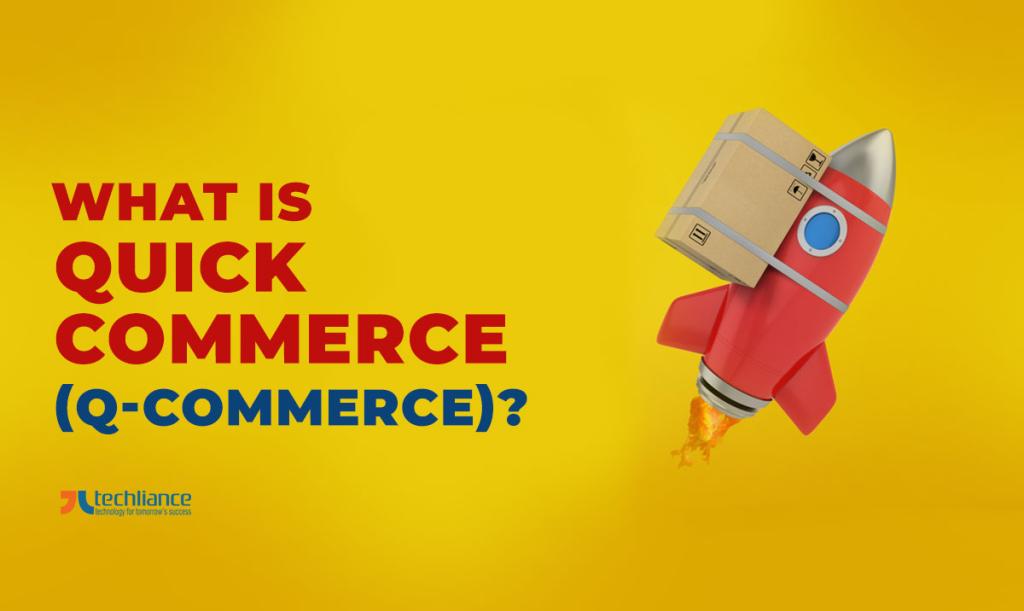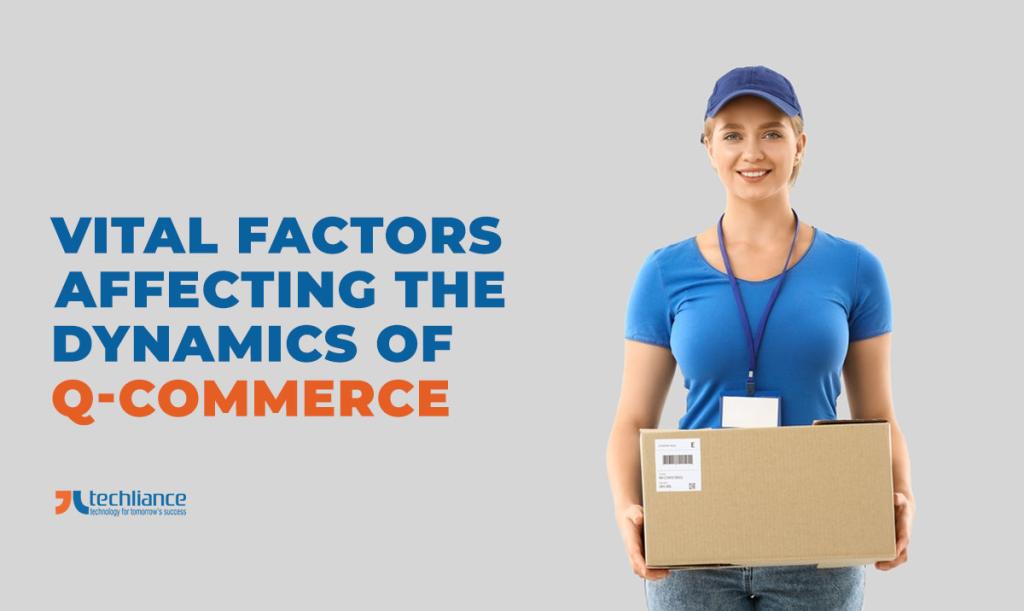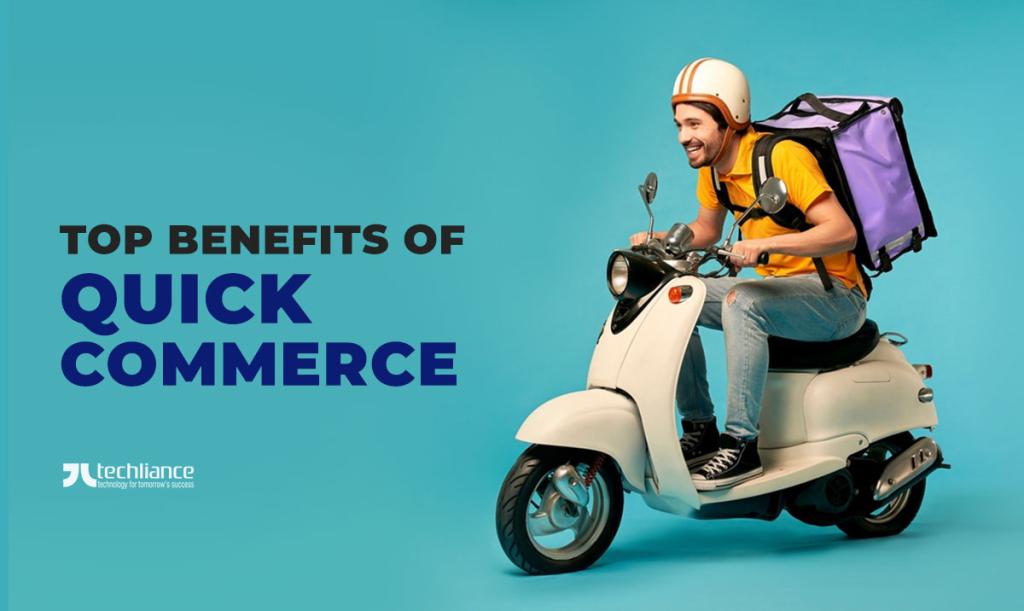People globally and in the USA are living in fast mode. We make decisions within seconds and the smartphones in our hands dictate what we do, and how we do it. That’s why quick commerce (Q-commerce) has become such a rage during 2023.
Quick commerce allows users to instantly shop for items. This fast mode of eCommerce enables customers to get the delivery of products to their doorsteps without any hassle. Why bother about going to the grocery store when your items can come to your home?
Online businesses are going above and beyond to better serve customers. As the concepts like Q-commerce and live-streaming are evolving consumer-facing businesses. Expert on-demand programmers can build robust solutions that ensure instant ordering and delivery of products.

Table of contents
- Summary
- What is Quick commerce (Q-commerce)?
- Vital factors affecting the dynamics of Q-commerce
- Top benefits of quick commerce
- Statistics of Q-commerce showing its growth
- Conclusion
- FAQs about Quick commerce (Q-commerce)
Summary
TLDR — Here is a short rundown of Q-commerce and key takeaways that you can derive from quick commerce.
- Q-commerce is similar to eCommerce but it varies in delivery of items with quicker delivery of goods.
- The main concern that Q-commerce businesses have is they need to account for the management of warehouses within the city.
- Also, the fast mobility of riders to speedily dispatch delivery to customers is paramount.
- Artificial intelligence plays a great role in predicting various data models for quick commerce.
- Q-commerce companies can remain efficient in their inventory, stocking, and delivery of goods; without running out of items.
- Quick commerce is a thriving market with an exciting future worldwide and in the United States.
- Customers prefer the comfort of ordering products from their homes.
- Q-commerce firms sensing the market need are making the product ordering and delivery process easy and swift.
What is Quick commerce (Q-commerce)?
Quick commerce (Q-commerce) is a rapid eCommerce concept with ultra-fast and extremely efficient delivery of online orders to customers. Companies have to deliver products within an hour, or as instant as 15 minutes. So, they have to maintain fantastic procurement and logistics capacities to fulfill orders.
Instant, fast and efficient — are the three features that play a pivotal role in defining the dynamic for quick commerce. This is also known as its shorter form of Q-commerce or on-demand delivery. The changing shopping patterns of people owing to COVID-19 are making people embrace it.

Vital factors affecting the dynamics of Q-commerce
Different aspects of quick commerce that need consideration through 2023 include the following.
Now, we discuss these facets of Q-commerce in brief.
Your genie in a bottle
Doesn’t this sound amazing? It’s like rubbing a lamp with a genie in command that makes your wish appear right in front of you. What’s better than your demand getting fulfillment in just a matter of minutes?
By this time, you know that quick commerce is so spectacular. Why isn’t Q-commerce as widespread and popular as it should have been? What’s the catch here?
Realize that quick commerce is not suitable for all products. Q-commerce is mainly for consumer items that businesses can deliver instantly. For instance, think of the worth of food ordering for customers.
Restaurants and food delivery services are part of q-commerce. Generally, an order needs delivery within 30 minutes — otherwise, it’s of no use to the consumer. Fresh groceries delivery is another example, with customers waiting for it so that they can quickly get down to cooking.

Warehousing
The majority of eCommerce stores don’t need to have their warehouses within the city. Because their delivery time is usually 24-48 hours from order placement. So, it gives them enough time to collect products and dispatch the order from the warehouses wherever they are.
Even, they can procure goods from the suppliers, if they are short. They can send items to the customer’s address through their delivery service. However, q-commerce businesses need to have warehouses within the city.
So that they are extremely reachable and nearby to serve prospective customers. They need to build a wide chain of micro-fulfillment centers or dark stores inside the city, as the service areas. So that each of the marked areas can get the goods without any delay.
Goods mobility
Talk about inter-city delivery that you have to match with equal efficiency. Quick commerce businesses can’t have big loading trucks delivering groceries to customers. Rather, they need a fleet of riders or delivery personnel with motorbikes.
The riders can carry a few items on their two-wheelers to places within reach. Moreover, the ability to use smarts is essential for them. Such that they can find routes that have the lightest traffic.
This is a huge factor in the success of q-commerce businesses internationally and the US. They entail a network of riders who are connected to the system through customized rider apps. Whereas, businesses have admin dashboards/apps and customers track their orders with user apps.
Tip: Ways for drafting services sales proposal for technology businesses
Top benefits of quick commerce
Here are the best advantages of Q-commerce in 2023.

Read on and you’ll see the value that quick commerce brings throughout 2023.
The power of science
Q-commerce is taking into account powerful AI and performant ML-driven solutions. Accordingly, quick commerce companies are better capable of dealing with customers. One big aspect of electronic commerce in general is to predict and forecast user demand.
How could q-commerce stay behind? The same concept applies here. Subsequently, it helps businesses focus on better build-up of products.
So that they don’t run out of items when customers are placing orders. Likewise, they can analyze which service areas or regions will have a high demand for specific items at specific times. Also, they can reduce inventory wastage when the demand for products decreases.
Speedy Gonzales
This reference to Speedy Gonzales is certainly a no-brainer. Quick-commerce is all about speeding up customer orders. So that consumers receive products within 15 minutes to an hour after the order.
Before the coronavirus pandemic, there was the concept of package delivery. Businesses even took about 5 working days for delivering the order. This was an acceptable norm back then.
However, everything changed during the COVID-19 times. People staying at their homes weren’t able to visit markets and brick-and-mortar stores to buy products. Nevertheless, they couldn’t wait for items of necessity to arrive within 5 working days.
Something had to change, and Q-commerce was the calling. This has become the new way of fulfilling orders for customer-facing businesses. Quick commerce allows a decent number of businesses to instantly confirm orders and rapidly deliver products to customers.
Eco-friendliness
Another aspect to deliberate on is that online businesses must efficiently utilize delivery riders. Yes, you will save valuable money by cutting fuel expenditures. Additionally, you will also take into account the environment.
Making our planet a greener place by leaving a lesser carbon footprint is necessary. One way to achieve this is to identify the shortest routes to reach customers to dispatch orders. Another way is to collectively serve the consumers in one go, who live near each other.
Riders don’t have to make singular trips to customers any longer. The smart usage of AI/ML algorithms also empowers higher and more efficient utilization of riders. Thus, riders can take up multiple orders on an efficient route and deliver items together.
Anytime at your command
Quick-commerce businesses usually have round-the-clock operations and permit users to order at any time. So, they don’t restrict customers to ordering products at any specific hours during the day. There is no concept of peak hours anymore.
Fear of missing out (FoMO) is a real concern for many users. Consumers don’t have to worry about the non-availability of their favorite items. They can easily shop at any time at the convenience of their houses.
In addition, they can get instant delivery in under an hour. This benefit is two-fold. Convenience is a factor that is so amazing if you have the right app.
It can work perfectly for ordering the quality products you need without having to worry about wrong orders. They don’t have to get anxious about hidden prices or expired produce reaching them. These are some of the aspects that the businesses within the Q commerce domain need to take care of.
You want to become the go-to app/service for consumers. If they are not happy with your services then you are out. It’s a huge win for the q-commerce business to have a whole level of trust from users. They not only order but ensure that they remain regular customers of the business.
Statistics of Q-commerce showing its growth
Let’s just get our facts on different regions to see what it’s like for quick commerce. Statista is always one of the most reliant survey-conducting organizations. It even speculates on global trends as per the current data.
The international Q-Commerce market value stands at $91.22bn USD in 2022. This is forecast to reach $185.10bn USD by 2027, with a CAGR of 15.20%. The number of users will grow to 789.1m by then.

People are willing to purchase quality FMCG products like groceries, drinks, vegetables, etc. That too right from the comfort of their homes. Therefore, the biggest reason for this growth is that the consumer market is heartily welcoming this expansion.
A study finds that 52% of customers opting for digital grocery shopping will not revert to in-store shopping. The revenue for quick commerce in MENA (the Middle East and Northern Africa region) will hit $20 billion by 2024. Q-commerce startups are raising serious funding around the world.
People rather pay more on delivery charges than get out of their homes to buy such goods. Comfort over slightly extra delivery charges is a better tradeoff than actually going around to shop for consumer items. Above and beyond, they find quick delivery of Q-commerce a better option than waiting for a few days.
Conclusion
The world was a very different place before the coronavirus pandemic. There was such a hustle and bustle throughout the world. After the breakout of COVID-19, it was all about remote availability and connectivity with each other.
This led many e-commerce and q-commerce businesses with opportunities to explore their market potential. As a result, quick commerce became a great way of doing business. Besides, to quite an extent — a necessity for consumers.
Thankfully, now we are returning to our normal routines. The comfort of having online purchasing of consumer goods is something we all want. Let’s admit it, we are busy hustling about.
This is better if we receive groceries while we do some other chores. Running out of milk at the eleventh hour will not feel like such a bummer. You can promptly order without moving an inch from your sofa when you are watching your Sunday night soccer game.
Quick commerce (just like its parent eCommerce) will continue to grow with advancements like live streaming. So, evolve your business with a quick-selling website or app now. Techliance can collaborate with you to make this transition in little time.

FAQs about Quick commerce (Q-commerce)
These are some frequently asked questions about quick commerce (Q-commerce).
E-commerce is a broader term for online purchases of different types of goods and services. Whereas, q-commerce caters to fewer FMCG items so that businesses can deliver products as instantly as possible.
Quick commerce (Q-commerce) can facilitate the purchasing of various kinds of products. However, it is most suitable for the sales of fast-moving consumer goods (FMCG). For example, groceries, snacks & beverages, healthcare, bath & beauty, office supplies, baby essentials, home care, and pet essentials.
Among the famous Q-commerce companies are Gorillas, Weezy, FridgeNoMore, Jokr, Zepto, Swiggy’s Instamart, Dunzo Daily, and Blinkit. Another leading Quick commerce business is Getir. It even got its Series E funding of $768 million in 2022.
North America is the most successful region for Quick commerce. Europe and Asia Pacific closely follow it for Q-commerce embrace. The reason for success lies in the fact that consumers have a very busy lifestyle.
Add to it a lesser support system that enables them to be more reliant on online shopping channels. Also, the consumer market of quick commerce has a good number of senior citizens. They now prefer online delivery of products instead of visiting supermarkets.
Artificial intelligence and machine learning are among the greatest enablers for eCommerce businesses. AI and ML help in creating a very personalized experience in Quick commerce too. They do so by analyzing customer data sets and then identifying patterns for deciphering consumer behavior.
Furthermore, globally AI and machine learning are also evolving too. This makes them the right fit for consumer-facing Q-commerce businesses now. AI and ML are even able to track demand for companies so that they can adjust their inventory in real-time.
About the Author




